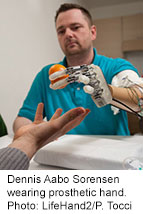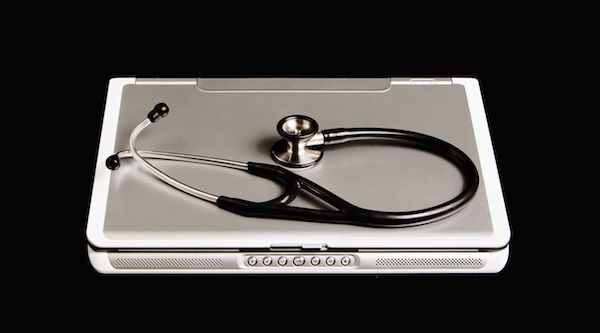
WEDNESDAY, Feb. 5, 2014 (HealthDay News) — A Danish man who lost his left hand in an accident almost a decade ago recently was able to “feel” an object using a state-of-the-art prosthetic hand, researchers are reporting.
Dennis Aabo Sorensen is the first amputee to feel what researchers call “sensory-rich information” in real time, said the authors of a study published in the Feb. 5 issue of the journal Science Translational Medicine.
“I could feel round things and hard things and soft things,” the 36-year-old dad said in a YouTube video report. “It was quite amazing because suddenly I could feel something that I hadn’t been feeling for nine years.”
Several European universities and hospitals collaborated to develop the “bionic” hand, which is outfitted with sensors in each finger that detect touch-related information. About a year ago, the artificial hand was connected to electrodes surgically implanted in nerves at the top of Sorensen’s arm. In a person with a healthy hand and arm, these nerves carry messages from the fingers and hand to the brain, regarding, for example, how firmly to grip an object.
In Sorensen’s case, the sensors in the hand sent an electrical signal to a computer. Using algorithms, the scientists transformed the electrical signal into an impulse that was received and understood by the electrodes at the top of Sorensen’s arm, which then relayed the signals into the nervous system.
This is the first time such electrodes have been implanted into the peripheral nervous system of an amputee, the scientists said in a journal news release.
“During these experiments, he was voluntarily controlling the prosthetic hand,” said study author Stanisa Raspopovic, a researcher in the Translational Neural Engineering Lab at the Federal Polytechnic School of Lausanne, in Switzerland. “We are stimulating his nerves as close to the way that we are doing it naturally. We are transmitting information to the brain in a very clever way.”
The researchers describe it as the ability to “sense and modulate grasping force.”
“The sensory feedback was incredible,” said Sorensen, whose hand was amputated after a fireworks accident.
After a week, the electrodes were removed for safety reasons.
Experts in the field welcomed the report.
“This is really exciting,” said Dr. Benjamin Chang, an associate professor of plastic and reconstructive surgery at the University of Pennsylvania’s Perelman School of Medicine.
“One of the problems we’ve had with prostheses in the past is that you have to teach the patient how to control and exert force because they get no feedback,” Chang said. “This has great potential for making a prosthetic close to replacing a regular limb.”
Chang said it’s not known what the long-term result will be with this particular electrode. “One of the things you always worry about is infection, or a reaction to the material,” he said.
Gayle Severance, an occupational therapist and certified hand therapist at Penn Presbyterian Medical Center in Philadelphia, was enthusiastic about the study.
“This is huge,” she said. “People accept lower extremity prosthetics so much faster. But with the hand — if you can’t feel, if you don’t have sensation — you have to use your eyes to guide you. When you go to grab a glass, the amount of feedback you get is important.”
Raspopovic said the technology, which is still very experimental, theoretically could be used on the lower limbs as well. But he cautioned that it’s much too early to say when a sensory prosthetic will be available commercially, and their research is not aimed at creating androids.
Clinical trials are being planned for next year, Raspopovic said. “We are roughly thinking a few patients, but can’t say a precise number at this time,” he said.
Will the prosthetic be affordable if it hits the mass market one day? “Our goal is to make something that will be affordable,” Raspopovic said.
More information
To see the researchers and patient, watch the video Amputee Feels in Real-Time With Prosthetic Hand.
Copyright © 2025 HealthDay. All rights reserved.

